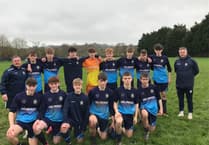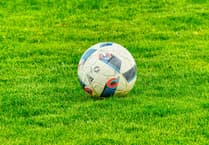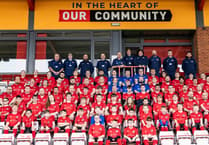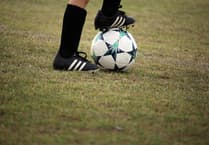MUCH of Ian’s childhood was spent watching or playing sport and particularly many hours kicking a ball about until daylight finally faded with other boys from the Eastern end of the town.
Their favourite spot was the Crediton “Rec” – now the Rugby Club’s junior team’s pitches.
One day a man watching them playing asked them if they would be interested in forming a boy’s football team.
That man was Tom Elston and through him the East Town team he formed became a Crediton United Youth team.
When Ian was around 12 years-old he developed a knee condition which was in those days not commonly recognised but years later named after the man who researched it.
The condition occurs during the development of adolescent boys when the tibia and fibula bones below the knee and the femur above the knee grow at a different rate.
Little was known of this condition in those days so rest was the order of the day and Ian was unable to enjoy much sport for a couple of years. (The condition was probably Osgood-Schlatters disease – ed).
When Ian was about 15 years-old he joined Crediton United Football Club and played in the second team and then eventually made the First Eleven.
A few years later in 1954 a friendly game was arranged between Crediton United and Exeter City to raise money for the Club. The ground at Newcombes Playing Field was packed with local supporters and the Crediton team “narrowly” beaten by a 10-0 scoreline.
Included in the Exeter City team that day were former Crediton United players Fred Davey, Keith Harvey and Bill Ellaway. Also present at the game was Stan Hurst, a former pre-war professional player for City.
Despite missing a penalty Ian must have caught the eye of City manager Norman Dodgin who afterwards asked Ian if he would like to sign amateur playing forms for Exeter.
Ian initially played in the Exeter City A team in the then Exeter and District League against teams like Tiverton, Exmouth, Dawlish, Friernhay and Heavitree, but in 1955 signed part-time professional forms and became a regular in the “Stiffs” (as they were then referred to by the First Team players) playing in the Western League.
After a good performance in a game against Hereford in which he scored two of goals, Ian was called in to the manager’s office to be told that he was to be in the First Team at home at St James’ Park the following Saturday, January 21, 1956, against Coventry City.
Even after nearly 60 years, Ian recalls his League debut well: “I remember a lot of that game. Early on I was fouled cutting in from the wing. I took the free kick straight on to the head of Graham Rees – a good friend of mine – and he scored in front of a crowd of 7,472. Eddie Murphy scored a second from my corner kick in the second-half but sadly we lost the game 2-3.”
At the same time three other former Crediton players Fred Davey, Keith Harvey, and Bill Ellaway were playing for City and on February 4.
Ian was very proud to make up the “Kirton” quartet in the team away at Brentford. Sadly they lost 0-2 in front of a crowd of 6,300. That was in the days of no substitutes remember.
Soon after this Ian’s career took a downward turn with a knee injury which plagued him for the next 18 months.
Struggling to regain fitness, playing and then breaking down again became a familiar pattern.
Eventually, although doctors at that time were reluctant because of potential arthritis problems in later life, a cartilage operation was necessary. In those days this type of operation was serious surgery and very invasive – not like the keyhole surgery available nowadays.
Having regained some degree of fitness Ian was then obliged to join the RAF for two years to do his stint of National Service. Following basic training Ian was transferred to his permanent camp at Innsworth, in Gloucestshire, where he was able to resume his sport, playing both football and cricket in the United Services Sports of Wiltshire League.
During a game at RAF Lyneham he picked up a second serious knee injury this time in the other leg and any chance of extending his professional career was ended prematurely with this bitter blow.
Who is to know how far Ian would have gone in the professional game but two serious knee injuries before the age of 21 years old was a real setback.
Ian’s friend Graham Rees, always a part-timer for City, played for them for a total of 370 games in 12 seasons. Playing wise Ian was a different class.
Ian eventually returned to play for his home town and was a loyal and influential player for the Club for many years.
Highlights of his remaining days with Crediton were being a part of the teams that won the then Exeter and District League Senior One championships in 1962/3 and again in 1966/7.
The Club became a big part of Ian’s life and he recalls: “I joined the Committee after finishing playing as at the time it was the done thing (but not any more it seems). Committees then were all powerful but gradually creeping into local teams was the perceived need to have team managers. In the late 60’s I was voted in as the first First Team manager and did the job for five years.”
Everyone has their favourite moment in football and for Ian it was a midweek floodlit game at St James’ Park around 1956. (I saw that game – ed).
He said: “I think the highlight of my playing days was when I played for City in a benefit match against a Manager’s International team which contained many of my football idols.
“Among these were Peter Doherty, Tommy Lawton, Rich Carter, Joe Mercer, Wally Barnes, George Hardwick and George Swindon household names of the era.
“I remember being brought down in the penalty area by George Hardwick who once captained a Great Britain team but unfortunately I didn’t get to take the penalty.”
In January 1987 Ian and Jean Grinney sponsored a Crediton United match and this gave programme editor Chris Gillard the opportunity to produce some interesting career details of this stalwart player and officer of Crediton United.
Chris wrote: “It would be no exaggeration to say that Crediton United would not be where it is today if it had not been for Ian.
“Nine years ago when we were planning our Clubhouse, whilst others dithered, Ian’s enthusiasm and foresight encouraged others.
“Ian has had a lifelong passion for football and Crediton United, in particular, and we hope we can see him kicking every ball on the touchline for many, many years to come.”
Colin White and Chris Gillard




